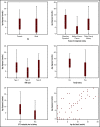Characteristics, complications, and sites of bleeding among infants and toddlers less than 2 years of age with VWD
- PMID: 33877293
- PMCID: PMC8095137
- DOI: 10.1182/bloodadvances.2020004141
Characteristics, complications, and sites of bleeding among infants and toddlers less than 2 years of age with VWD
Abstract
Data on infants and toddlers (ITs) with von Willebrand disease (VWD) are lacking. We used data collected in the US Hemophilia Treatment Center Network (USHTCN) to describe birth characteristics, bleeding episodes, and complications experienced by 105 patients with VWD who were <2 years of age. In 68% of the patients, the reason for diagnostic testing was a family history of a bleeding disorder. The mean age at diagnosis was 7 months, with little variation by sex. Patients with type 2 VWD were diagnosed earlier than those with types 1 or 3 (P = .04), and those with a family history were diagnosed ∼4 months earlier than those with none (P < .001). Among the patients who experienced a bleeding event (70%), oral mucosa was the most common site of the initial bleeding episode (32%), followed by circumcision-related (12%) and intracranial/extracranial bleeding (10%). Forty-one percent of the initial bleeding events occurred before 6 months of age, and 68% of them occurred before the age of 1 year. Approximately 5% of the cohort experienced an intracranial hemorrhage; however, none was associated with delivery at birth. Bleeding patterns and rates were similar by sex (P = .40) and VWD type (P = .10). Forty-seven percent were treated with plasma-derived von Willebrand factor VIII concentrates. The results of this study indicate that a high percentage of ITs diagnosed with VWD and receiving care within the multidisciplinary structure of the USHTCN have a family history of VWD. In addition, bleeding events such as circumcision-related, oropharyngeal, and intracranial or extracranial episodes are common and are leading indicators for treatment.
Conflict of interest statement
Conflict-of-interest disclosure: The authors declare no competing financial interests.
Figures



Similar articles
-
Von Willebrand's disease: case report and review of literature.Pan Afr Med J. 2017 Jun 29;27:147. doi: 10.11604/pamj.2017.27.147.12248. eCollection 2017. Pan Afr Med J. 2017. PMID: 28904675 Free PMC article. Review.
-
The natural history of occult or angiodysplastic gastrointestinal bleeding in von Willebrand disease.Haemophilia. 2015 May;21(3):338-342. doi: 10.1111/hae.12571. Epub 2014 Nov 7. Haemophilia. 2015. PMID: 25381842
-
Bleeding symptoms and laboratory correlation in patients with severe von Willebrand disease.Haemophilia. 2009 Jul;15(4):918-25. doi: 10.1111/j.1365-2516.2009.02025.x. Epub 2009 Apr 7. Haemophilia. 2009. PMID: 19473418
-
Are Iranian patients with von Willebrand disease type 2N properly differentiated from hemophilia A and do they receive appropriate treatment?Blood Coagul Fibrinolysis. 2020 Sep;31(6):382-386. doi: 10.1097/MBC.0000000000000932. Blood Coagul Fibrinolysis. 2020. PMID: 32815913
-
Prophylaxis escalation in severe von Willebrand disease: a prospective study from the von Willebrand Disease Prophylaxis Network.J Thromb Haemost. 2015 Sep;13(9):1585-9. doi: 10.1111/jth.12995. Epub 2015 Jul 14. J Thromb Haemost. 2015. PMID: 25930155 Review.
Cited by
-
Genotype-Phenotype Relationship among 785 Unrelated White Women with Inherited Congenital Factor VII Deficiency: A Three-Center Database Study.J Clin Med. 2023 Dec 21;13(1):49. doi: 10.3390/jcm13010049. J Clin Med. 2023. PMID: 38202056 Free PMC article.
-
Clinical and laboratory presentation of von Willebrand disease: Experience from a single center in Saudi Arabia.J Taibah Univ Med Sci. 2022 Nov 14;18(2):413-419. doi: 10.1016/j.jtumed.2022.10.019. eCollection 2023 Apr. J Taibah Univ Med Sci. 2022. PMID: 37102076 Free PMC article.
-
Von Willebrand disease (VWD) and pregnancy: a comprehensive overview.Thromb J. 2025 Apr 28;23(1):41. doi: 10.1186/s12959-025-00727-7. Thromb J. 2025. PMID: 40296027 Free PMC article. Review.
References
-
- Cabrera ME, Artigas CG, Páez E, et al. . Enfermedad de von Willebrand en la IX Region de Chile. [Von Willebrand’s disease in the IX Region of Chile]. Rev Med Chil. 1989;117(4):423-430. - PubMed
-
- Werner EJ, Broxson EH, Tucker EL, Giroux DS, Shults J, Abshire TC. Prevalence of von Willebrand disease in children: a multiethnic study. J Pediatr. 1993;123(6):893-898. - PubMed
-
- Rodeghiero F, Castaman G, Dini E. Epidemiological investigation of the prevalence of von Willebrand’s disease. Blood. 1987;69(2):454-459. - PubMed
-
- Nitu-Whalley IC, Lee CA, Griffioen A, Jenkins PV, Pasi KJ. Type 1 von Willebrand disease - a clinical retrospective study of the diagnosis, the influence of the ABO blood group and the role of the bleeding history. Br J Haematol. 2000;108(2):259-264. - PubMed
Publication types
MeSH terms
Substances
LinkOut - more resources
Full Text Sources
Other Literature Sources

